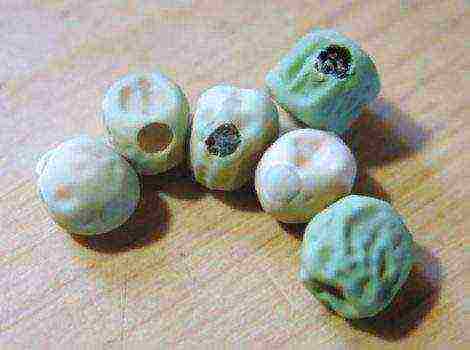Content
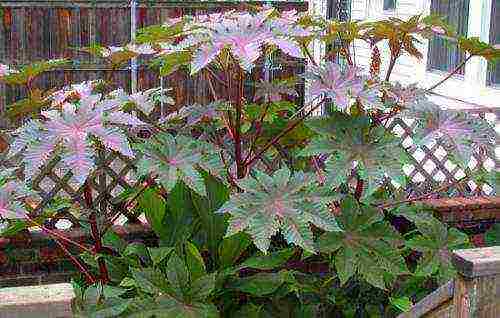
The popularity of castor oil plant only increases every year. Outwardly, it looks like an exotic palm tree. It is a strong plant with large leaves that look like maple leaves. Nowadays it can be found in almost every yard, where they are used for hedges or flower beds.
In our country, castor oil plant has several names, the most popular are "castor oil", "paradise tree" and "Turkish hemp". This culture develops very quickly, the leaves of the plant are 7 or 9 ray, resemble a maple leaf. Most often it is grown in an annual culture, castor oil is isolated from the seeds.
Attention! Homemade castor oil is poison. To remove toxic components, the original liquid requires special processing in an industrial environment. Do not try to use in a product squeezed from castor bean seeds - it killed many people.
Now this plant is used as an ornamental culture. Thanks to the variety of species bred by breeders, each gardener will choose the right "palm" for himself. Castor oil plants form inflorescences in late summer. Under optimal external conditions, the development of some species is very rapid, some specimens grow up to 10 meters.
Castor oil plant: planting seedlings
This is one of the crops that is grown at home mainly by seeds, it is very unpretentious. You just need to carefully choose a place for planting it - the soil should be constantly moist, nutritious and loose. It will grow best on black soil, but you will have to create a good drainage layer for it.
Castor oil loves the sun's rays and is thermophilic - in case of slight frosts, the plant dies, does not like gusts of wind and drafts. The seeds are sold in many shops and can be harvested from nearby plants.
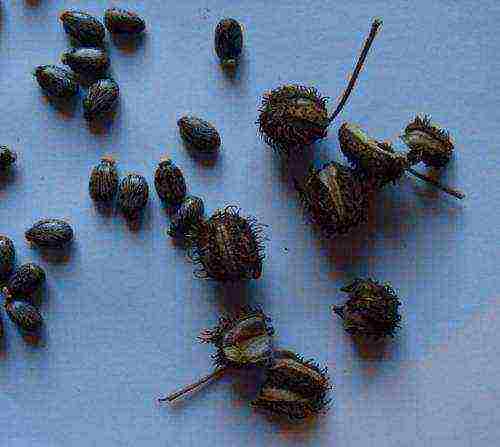
It is better to grow it in a seedling way - this will make it possible to get stronger and rise in time and castor bean bushes from seedlings will not suffer from late frosts. In order to get seedlings on time, seeds are sown no earlier than the second decade of March and before the beginning of summer. Seedlings are transplanted into flower beds in May.
Growing seedlings
Plants of this culture develop quickly and, having sown seeds in March, there is no need to fear that the bushes will not have time to form seeds before the first frosts. Although some owners argue that it is better to sow castor oil plants in April.
Each seed needs to be planted in its own pot. Do not put 2-3 seeds in one container, very soon the seedlings will become cramped. Seeds should be soaked in warm water 24 hours before sowing, while they are saturated with moisture, you need to change the water several times.
You cannot immerse the seeds in the soil deeper than 6 cm; after sowing, the pots are covered with gauze and transferred to a warm place. If the sticky peel has not fallen off the cotyledons, it must be removed with tweezers, otherwise this can cause rotting of the leaves and sprout. Do not forget - the sun's rays are life-giving for castor oil plants. Watering the seedlings begins after the appearance of the first key.

First, a seedling appears and stretches above the ground, after which the first leaf is formed, during this period the pots should be placed in a well-lit cool place where the temperature is maintained at about 15 degrees. As the seedlings grow, add soil to the pots until they are full. Growing seedlings too quickly will require transplanting the seedlings into larger pots.Sometimes, by the time of transplanting to a flower bed, the height of the seedlings can reach 1 meter.
Transplanting
When the risk of recurrent frosts disappears and the nights become warm, they begin to plant castor oil plants in flower beds. Young plants are very delicate, you need to work with them as carefully as possible. In addition, it is important not to damage the root system of the seedlings, otherwise they will die. For this reason, before starting work, they are well watered, so the earthen lump with roots will not fall apart. You can generally cut the pots and then plant the plants. For plants, not very deep holes are prepared - so as to cover the root to the bottom leaf.
Castor oil plant: sowing by seeds in the ground
You can not fool your head with seedlings, but plant castor bean seeds. Only for this you need to choose a time when the air temperature does not fall below 12 degrees. The seeds need to make their "way to life" easier, they have an oily, dense film that is difficult for sprouts to break through. They need to be pre-treated with sandpaper, so the sprouts will appear sooner (this is called scarification) - after three weeks you will notice the first keys. You can put 3 castor bean seeds in each hole.
Castor oil plant: care
In nature, no one cares for castor oil plants, but in our climate it needs care. Timely, complete and high-quality care is a guarantee of a healthy and beautiful plant.
The castor oil plant is very fond of watering, it is very important during any period of plant growth. It needs to be watered regularly every 5 days, pouring 10 liters of water onto the bush. This culture develops throughout the growing season - it spends summer on a set of vegetative mass, the formation of flower stalks and seed growth. For this reason, it is advisable to feed her regularly.
• Before flowering, solutions containing nitrogen fertilizers are poured under the bush or manure is added;
• After the inflorescences are formed, the plants need to be fed with phosphorus-potassium compounds.
Do not forget that for a young castor oil plant, it is necessary to provide supports.
Take into account! The seeds of this beautiful plant contain poison! 6 seeds of the plant is a lethal dose for a child!
Do not allow children to play, swallow or pick leaves near plants. Castor oil cake is just as poisonous, although it is an excellent fertilizer that additionally repels many pests.
Pests and diseases
The castor oil plant perfectly resists pests and diseases, but she also has her troubles. Young plants can be damaged - sandy slugs, caterpillars of the meadow moth and winter moth, false wireworms and wireworms. This is another reason to take the time to prepare strong seedlings. During the formation of inflorescences and flowering, meadow bugs can gnaw them. You can simply destroy them - while they have not multiplied, you can collect the pest by hand, if there are a lot of them, then treat the bushes with a decoction of wormwood - leave 1/3 of the chopped grass for three days in a bucket of water. Then strain the solution and spray the plants.
If garlic, onion, coriander, mint, dill or parsley grow near the castor-bean bushes, then few pests will crawl onto your "palm". It is better to deal with a false wire and wireworm in advance, so it is easier to destroy it. When planting plants in the ground, it is necessary to shed the prepared holes with potassium permanganate.
Plants sometimes get sick - powdery mildew, late blight, phyllosticosis, cercospora, bacteriosis, and various rot. Bushes can become infected with fungal diseases; only treatment with Bordeaux liquid or similarly acting compounds can save them from them.
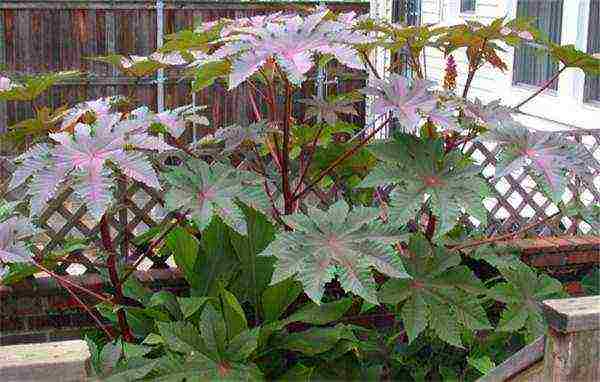
The popularity of castor oil plant only increases every year. Outwardly, it looks like an exotic palm tree. It is a strong plant with large leaves that look like maple leaves. Nowadays it can be found in almost every yard, where they are used for hedges or flower beds.
In our country, castor oil bears several names, the most popular are "castor oil", "paradise tree" and "Turkish hemp". This culture develops very quickly, the leaves of the plant are 7 or 9 ray, resemble a maple leaf. Most often it is grown in an annual culture, castor oil is isolated from the seeds.Attention! Homemade castor oil is poison. To remove toxic components, the original liquid requires special processing in an industrial environment. Do not try to use in a product squeezed from castor bean seeds - it killed many people.
Now this plant is used as an ornamental culture. Thanks to the variety of species bred by breeders, each gardener will choose the right "palm" for himself. Castor oil plants form inflorescences in late summer. Under optimal external conditions, the development of some species is very rapid, some specimens grow up to 10 meters.
Castor oil plant: planting seedlings
This is one of the crops that is grown at home mainly by seeds, it is very unpretentious. You just need to carefully choose a place for planting it - the soil should be constantly moist, nutritious and loose. It will grow best on black soil, but you will have to create a good drainage layer for it.
Castor oil loves the sun's rays and is thermophilic - in case of slight frosts, the plant dies, does not like gusts of wind and drafts. The seeds are sold in many shops and can be harvested from nearby plants.
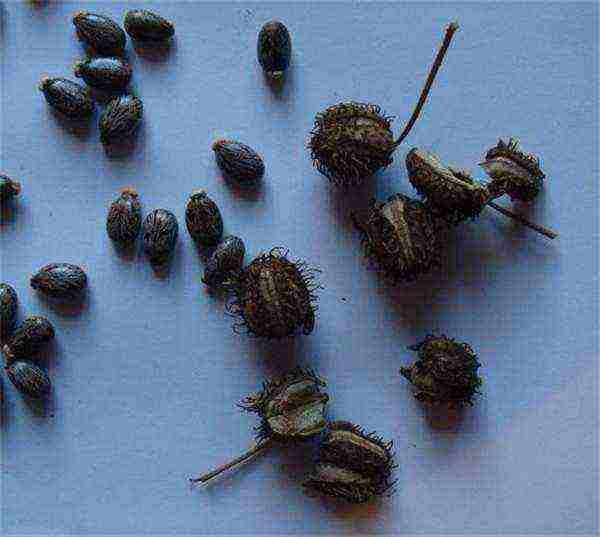
It is better to grow it in a seedling way - this will make it possible to get stronger and rise in time and castor bean bushes from seedlings will not suffer from late frosts. In order to get seedlings in a timely manner, seeds are sown no earlier than the second decade of March and before the beginning of summer. Seedlings are transplanted into flower beds in May.
Growing seedlings
Plants of this culture develop quickly and, having sown seeds in March, there is no need to fear that the bushes will not have time to form seeds before the first frost. Although some owners argue that it is better to sow castor oil plants in April.
Each seed needs to be planted in its own pot. Do not put 2-3 seeds in one container, very soon the seedlings will become cramped. Seeds should be soaked in warm water 24 hours before sowing, while they are saturated with moisture, you need to change the water several times.
You cannot immerse the seeds in the soil deeper than 6 cm; after sowing, the pots are covered with gauze and transferred to a warm place. If the sticky peel has not fallen off the cotyledons, it must be removed with tweezers, otherwise this can cause rotting of the leaves and sprout. Do not forget - the sun's rays are life-giving for castor oil plants. Watering the seedlings begins after the appearance of the first key.
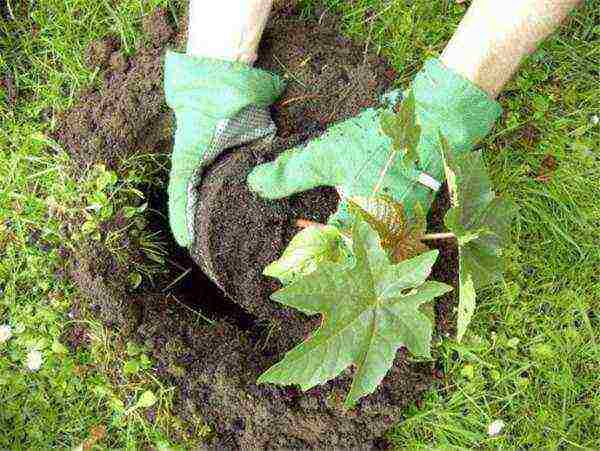
First, a seedling appears and stretches above the ground, after which the first leaf is formed, during this period the pots should be placed in a well-lit cool place where the temperature is maintained at about 15 degrees. As the seedlings grow, add soil to the pots until they are full. Growing seedlings too quickly will require transplanting the seedlings into larger pots. Sometimes, by the time of transplanting to a flower bed, the height of the seedlings can reach 1 meter.
Transplanting
When the risk of recurrent frosts disappears and the nights become warm, they begin to plant castor oil plants in flower beds. Young plants are very delicate, you need to work with them as carefully as possible. In addition, it is important not to damage the root system of the seedlings, otherwise they will die. For this reason, before starting work, they are well watered, so the earthen lump with roots will not fall apart. You can generally cut the pots and then plant the plants. For plants, not very deep holes are prepared - so as to cover the root to the lower leaf.
Castor oil plant: sowing with seeds in the ground
You can not fool your head with seedlings, but plant castor bean seeds. Only for this you need to choose a time when the air temperature does not fall below 12 degrees.The seeds need to make their "way to life" easier, they have an oily, dense film that is difficult for sprouts to break through. They need to be pre-treated with sandpaper, so the sprouts will appear sooner (this is called scarification) - after three weeks you will notice the first keys. You can put 3 castor bean seeds in each hole.
Castor oil plant: care
In nature, no one cares for castor oil, but in our climate it needs care. Timely, complete and high-quality care is a guarantee of a healthy and beautiful plant.
The castor oil plant is very fond of watering, it is very important during any period of plant growth. It needs to be watered regularly every 5 days, pouring 10 liters of water onto the bush. This culture develops throughout the growing season - it spends summer on a set of vegetative mass, the formation of flower stalks and seed growth. For this reason, it is advisable to feed her regularly.
• Before flowering, solutions containing nitrogen fertilizers are poured under the bush or manure is added;
• After the inflorescences are formed, the plants need to be fed with phosphorus-potassium compounds.
Do not forget that for a young castor oil plant, it is necessary to provide supports.
Take into account! The seeds of this beautiful plant contain poison! 6 seeds of the plant is a lethal dose for a child!Do not allow children to play, swallow or pick leaves near plants. Castor oil cake is just as poisonous, although it is an excellent fertilizer that additionally repels many pests.
Pests and diseases
The castor oil plant perfectly resists pests and diseases, but it also has its troubles. Young plants can be damaged - sandy slugs, caterpillars of the meadow moth and winter moth, false wireworms and wireworms. This is another reason to take the time to prepare strong seedlings. During the formation of inflorescences and flowering, meadow bugs can gnaw them. You can simply destroy them - while they have not multiplied, you can collect the pest by hand, if there are a lot of them, then treat the bushes with a decoction of wormwood - leave 1/3 of the chopped grass for three days in a bucket of water. Then strain the solution and spray the plants.
If garlic, onion, coriander, mint, dill or parsley grow near the castor-bean bushes, then few pests will crawl onto your "palm". It is better to deal with a false wire and a wireworm in advance, so it is easier to destroy it. When planting plants in the ground, it is necessary to shed the prepared holes with potassium permanganate.
Plants sometimes get sick - powdery mildew, late blight, phyllosticosis, cercospora, bacteriosis, and various rot. Bushes can become infected with fungal diseases; only treatment with Bordeaux liquid or similarly acting compounds can save them from them.
This plant causes a strange sensation in those who first saw it. Resembles an exotic palm tree in structure. The leaves are gorgeous, palmate-lobed, similar in shape to the leaves of a giant maple. The bush is high, impressive, up to four meters. The colors of the leaves are unusual. The castor oil plant, despite the dissonant name, gives the garden a spectacular subtropical flavor and oriental charm.
Castor oil plant in the photo
Common castor oil plant grows like an annual in our latitudes. The plant belongs to the euphorbia family. It has many varietal species that are used as ornamental in modern gardening. Homeland - subtropics. Africa. In the wild, it grows up to ten meters and grows for many years.
As a subtropical inhabitant, he loves humidity, light and warmth. Prefers loose, highly nutritious soil. Not suitable for potting. It is a poisonous plant.
In Russian, castor oil - (translated from Latin "ricinus"), which means a tick. The seeds of the plant are similar in appearance to a tropical mite. These "tick-like" seeds were found during excavations of the tombs of the pharaohs of Ancient Egypt by archaeologists.
Castor bean varieties
|
Zanzibar |
Stunted (no more than two meters).Leaves are bright blood-purple in color. |
|
Gibson |
Up to four meters high. The color of the leaves is metallic red. |
|
Cambodian |
Tall, up to six meters. It has dark leaves and an almost black trunk. |
|
Northern palm |
The most cold-resistant variety. The leaves are deep dark green. |
|
Impala |
Medium-sized variety. Bright red leaves with a touch of bronze. |
|
Kazachka |
Medium-sized variety with dark green leaves on dark red stems. |
Cultivation of castor bean
How to grow a beautiful castor oil plant
In our country, castor oil plant is grown during the spring-autumn season, because it does not tolerate even the slightest cold weather. This thermophilic annual is rather unpretentious and simple in agricultural technology.
- Loves the sun. It is necessary to grow in areas open to sunlight, otherwise the varietal color of the leaves will not be obtained.
- It does not tolerate not only frost, but even an ordinary cold snap, if it lasts more than a few days. Therefore, sowing in open ground is better done late than early. And it is better to prefer the seedling growing method.
- From soils it prefers nutritious chernozem. The soil should be cultivated, increased looseness, not heavy.
- Increased humidity is constantly needed. During drought, the leaves dry out and lose their decorative effect.
Sowing seeds for seedlings
Due to the fact that the threat of cold weather can destroy the plant, in order to make the growing season safe, castor bean seedlings are grown.
The plant propagates only by seeds, which are in spherical seed pods covered with sharp thorns, several pieces each.
During ripening, these capsules crack, and castor bean seeds spill out of them.
Castor bean seeds
It's time to sow seeds in March, but you can wish it all April and even May. Optimally mid-spring. The seeds sown at this time give amicable healthy shoots, are rapidly gaining growth, do not outgrow and do not stretch. Seedlings during the season have enough time to develop into a full-fledged powerful plant with all varietal characteristics. A plant that is fully ripe by the end of the growing season produces seeds suitable for subsequent sowing.
Castor bean seeds germinate for a long time. Germination is also not one hundred percent - out of ten hatch, at best, 2/3. Seeds need to be prepared for sowing. All methods are suitable - soaking, germination. But the most important preparatory moment, without which it will be difficult for castor bean seeds to sprout - scarification.
For scarification, the seed must be rubbed with sandpaper in order to reduce the tightness of the seed. This will break the shell and give the germ a better chance of being born sooner. After scarification, be sure to soak the seed. First, for a day in clean warm water, and then for another night - in a growth stimulator. Any stimulant can be used. Heteroauxin is the most effective in this case.
Heteroauxin
You only need to sow castor oil in separate plastic containers, which are quite voluminous and deep. More than half of the containers are filled with earth. The seeds sink into holes two centimeters deep. Fall asleep. Crops are sent to a warm place. They can be covered with plastic wrap or not.
The first sprouts of castor bean
After full processing, the seeds sprout quickly - sprouts appear within 5-7 days. It can be difficult for them to shed the oily shell. So that it does not cause the formation of rot in the pot, the shell is removed by hand, being careful not to damage the sprout.
Castor bean seedlings
Cotyledon leaves also form quickly. It is important at this time to maintain humidity and heat at the level of + 20 ° С… + 22 ° С.
But as soon as the first true leaf is outlined on the seedlings, it needs to be moved to a cool place - about + 16 ° C.
Important! Bright and long-lasting light is needed for seedlings at all stages, starting with pecking seedlings.
The castor oil plant grows quite intensively and it may happen that the area for feeding the pot is not enough for it.At first, you can simply fill the pot up to the top of the nutrient soil. Then - transplant the plant into a larger container.
Intensive growth of castor bean seedlings
Planting castor oil plants in the garden
It makes no sense to plant before summer - any cold will destroy a seemingly powerful and large plant. When June begins, the seedlings, having previously hardened, can be sent to the garden.
Before planting, you need to water the plants in pots well several times so that the whole clod of earth gets wet. It's hard to believe, but castor oil plant is afraid of transplanting - the roots are easily damaged and then recover for a very long time and poorly.
The wetted soil, together with the roots, must be removed from the pot without breaking the coma, and transferred to the prepared garden hole.
Planting a sprout in the soil
Sowing in the ground
If you don't want to grow seedlings at home, but you want to have exotic things on the site, you can sow seeds in the ground. But this is not done until May, closer to the middle. Since seedlings and young seedlings will not withstand even short and weak return frosts. For sowing in unprotected soil, the same seed preparation methods are used as for growing seedlings.
Holes are made in the soil. 2-3 seeds are sown in each hole. If all three or two sprout, weak shoots can be removed later.
Sowing seeds in the ground
Crops must be covered with foil at least at the first stage at night.
Bed covered with foil
Castor oil care
An adult plant is so unpretentious that it practically does not need care. Occasionally loosen the soil at the roots and weed out the weeds. And if you mulch it with bark or pebbles to preserve moisture, then you do not need to loosen and weed.
The only condition is regular watering. This should be monitored so as not to destroy the plant. Throughout the season, and especially in hot weather, castor bean is watered abundantly, with plenty of water, at least twice a week. Up to 10 liters of water is consumed per plant.
The castor oil plant will not be offended if it is not fed with anything but water. But he responds with gratitude to nitrogen-containing dressings, which allow the leaves to acquire the maximum size and high decorative effect. The plant especially needs nitrogen during the period of inflorescence formation, so that the seeds then ripen.
Castor oil plant is unpretentious and requires only watering
Important! The castor oil plant is poisonous. And not only seeds, which contain enough poison for the use of 5-6 to lead to poisoning with a fatal outcome in a child. For adults, the dose is three times more.
But it's not just seeds that are deadly to consume. In castor bean, the stem is also poisonous. Despite the fact that plant cake is used as a fertilizer, it is also used to combat pests living in the soil.
Beautiful but poisonous castor bean plant
Valuable castor oil is obtained from castor bean and used as a component in Vishnevsky's ointment, but only with appropriate processing, which can only be carried out at the enterprise.
For a long time, the castor oil plant was not in demand as a decorative element of landscape design. Today, the plant is increasingly used for oriental and African-style gardens. It can be used to decorate walls, plant along a fence, or use it in solitary plantings.
Castor oil plant - garden decoration
Video - Kleschevin
Video - How to grow castor oil plant
Every summer resident wants to have something exotic and unusual on his site. But not many can take the risk and plant something that is some kind of curiosity. And so I want to feel like on the island in the summer. This atmosphere can only be created by castor oil plants. Thanks to its palm tree appearance, you can travel wherever you want all summer. But before you run to the store for the seeds of this plant and buy them, you should know all the secrets of growing castor bean from seeds. Indeed, without them, you can not achieve the desired result.
General description of the plant and its types
Castor oil plant is a perennial plant that came to us from East and North Africa. The name "castor oil plant" comes from the Latin word "ricinus", which means "tick". The plant got this name because its seeds look like ticks. Many professional summer residents know about other names of castor oil plants. At the moment, the most popular are: "Turkish hemp", "castor oil" and "paradise tree".
This kind of palm tree appeared a long time ago. Many historians believe that the seeds of this plant were found in the sarcophagi of the Egyptian pharaohs. Perhaps this is also due to the shape of the seeds, which resembles the Egyptian scarab beetles. Castor bean has a rather exotic appearance. It has a straight stem, which can reach two meters in height; the leaves, depending on the variety, can have different shades. The most popular color is considered to be dark purple or green. Their shape resembles maple leaves.
This flower grows very quickly and its seeds are quite valuable because they can be used to obtain castor oil. But this does not mean that you need to make castor oil at home now. Everyone knows that castor oil plant is a poisonous plant. The seeds themselves undergo specialized processing and this is the only way to remove toxic substances from them. If you get castor oil at home and use it, then you or your loved ones will be fatal.
Today this plant is most often used as a decoration. Castor bean bloom occurs at the end of summer, or rather, in August. Some varieties, with proper care, can reach a height of 10 meters. At the moment, there are several of the most popular types of castor beans.
to the content ↑ Castor oil plant

This variety reaches a height of 100-120 centimeters. Has a green tint of both leaves and stem. In addition, the leaves are very large in size and have a glossy surface.
to the content ↑ Bourbon castor oil
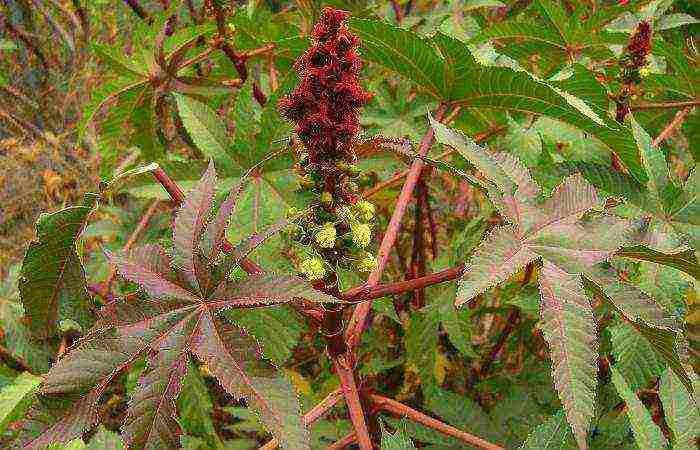
She is one of the tallest varieties of this plant, which can reach a height of three meters. He has a very strong, dense, tree-like trunk, red in color. Also, like the ordinary variety, the Bourbon castor bean has large leaves with a shiny surface.
Back to contents ↑ Zanzibar Castor oil
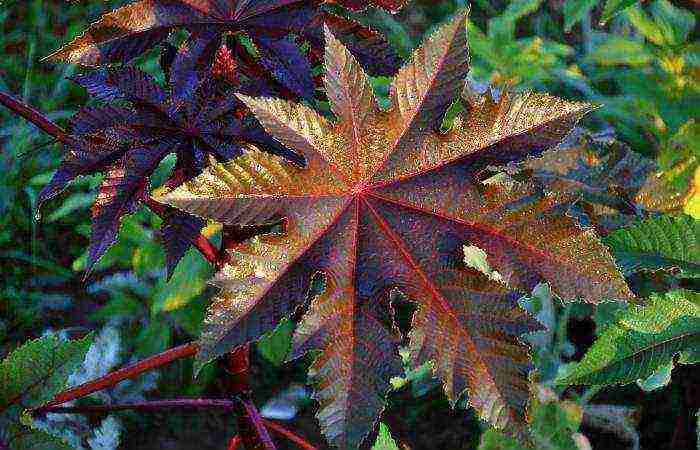
It has bright red leaves and a stem with a dark purple tint. This variety can grow up to two meters.
back to content ↑ Indian castor oil plant
Height no more than 120 centimeters. The trunk is very dark, almost black in color, and the leaves are dark green.
back to contents ↑ Gibson's castor oil
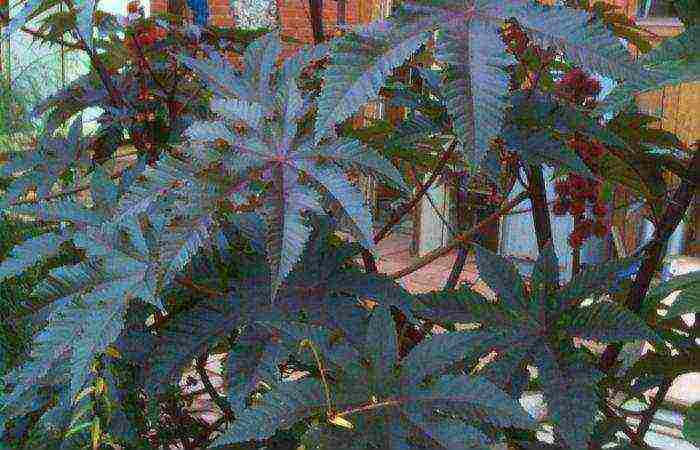
This variety has a height of about one and a half meters. The trunk and leaves are crimson in color.
back to contents ↑ Kasachka Kleshchevin
This is the most common type. It is a sturdy, branched plant with a red-brown stem and green leaves with small red veins.
to the content ↑ Features of sowing seeds for seedlings and in open ground
Castor oil plants will grow best in places where there is nutritious, loose soil that is sufficiently cultivated and moist. The ideal option for this plant is considered to be black soil with excellent drainage, and a site with a huge amount of solar heat and light.
It is important to remember that castor oil plants can grow poorly if planted in a completely open area with strong winds and drafts. From this they feel very bad and can quickly die.
As for the seeds, they can be found in a specialty store. They are not uncommon at the moment. It is recommended to sow seedlings:
- for seedlings - in March or April;
- in open ground - in May.
Most often, the planting of castor bean occurs through seedlings, since seedlings grown at home are best planted after the spring frosts have passed and the soil warms up a little.
It is very easy to get seedlings on your own at home, for this you do not need to be a summer resident with many years of experience.
Here you do not need to plant castor bean seeds in one common container, and then plant the seedlings in different containers. Initially, you must plant the seeds in separate pots. This is because it is a fast growing plant and the seedlings will be quite large.
But before planting them, it is necessary to soak the seeds in warm water for a day. This will help to achieve the best planting results and the sprouts will be strong. Do not forget that the water must be periodically changed to fresh. In order for the roots and soil to hold together well, the seedlings must be immersed in the ground to a depth of 2 to 6 centimeters.
In the future, caring for them is very simple. It is necessary to cover the pots with a piece of cloth, and transfer the containers themselves to a more illuminated area of the room, most often it is the window sill. Much to the surprise of many, it is not worth watering the soil, both before and after planting. It is necessary to wait for the appearance of the first shoots.
The outdoor transplant is planned for a period of time when the nights are much warmer and the spring frost is long over. At an early age, castor bean is a very fragile plant and transplanting can adversely affect it. Therefore, it is worth planting seedlings only together with a lump of soil from the pot. Such a transplant will reduce the risk of damage to the roots of the castor plant, and it will root better and faster in a new place.
But many decide not to bother with seedlings and immediately plant seeds in open ground. This method is now very popular, but with it you need to wait until the temperature outside stabilizes and does not drop below +12 degrees.
In this method, you also need to prepare castor bean seeds in advance. Its oily film is quite dense and it is necessary to help the sprout to break through to the top. Therefore, you need to gently rub each seed with sandpaper. So you will make it easier for him and the first borings may appear in 3-3.5 weeks. Depending on the variety, the depth of the hole can be from 2 to 10 centimeters and you can put from 1-3 seeds there.
back to contents ↑ Care of seedlings
Planting and grooming outdoors is fairly straightforward. In the first, you have already seen for yourself, now the turn has passed to the second point. Castor oil plant almost does not need care, as it is considered the most unpretentious plant. For a given plant, the most important thing is only good watering. Since it develops well, and most importantly quickly and does it throughout the season, it must be provided with regular hydration.
In order to provide this flower with a huge amount of moisture, you need to water it every 5 days with 10 liters of water for each plant.
Of course, with such abundant moisture, the castor oil plant will also need weeding. Indeed, without it, young plants will not be able to protect themselves from weeds. If you wish, you can feed the plant and feed it. It responds perfectly to any feeding, but best of all to nitrogen, especially if it is done before the formation of castor bean inflorescences begins.
Make sure that this palm tree also grows in your country next year. And for this you need to know when to collect castor bean seeds. At the end of August - at the beginning of September, this plant reaches the peak of its splendor and bolls have already formed on the first peduncles. They begin to dry out and so they need to be harvested to get seeds. Then the boxes must be laid out on the surface and dried well.
If the autumn frosts came earlier, and you did not have time to collect the required amount of seeds, then this is not a problem. You can cut off the most mature flower stalks with a pruner. The seeds that are inside are already ready for further use.
When all the work in the garden is finished and there is more time, then you can remove the seeds from the boxes. By that time, they dry out very well and can be easily obtained.Put on gloves and knead the pods and take out 2-3 seeds. Gloves are needed in order to protect your hands from the thorns that cover the seeds.
This rather simple work should never be done in the presence of children. Since they can take these seemingly harmless seeds into their mouths. But they contain poison, and this can lead to disastrous consequences.

